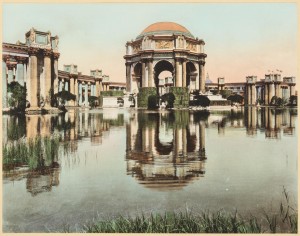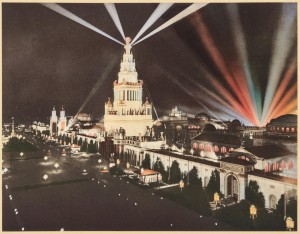In celebration of the 100th anniversary of the Panama Pacific International Exposition (PPIE), PBA Galleries will offer numerous rare mementos from this beloved World’s Fair in Sale 560 on May 14th, 2015. The PPIE was a celebration of the completion of the Panama Canal and the 400th anniversary of the discovery of the Pacific Ocean. When President Taft announced that San Francisco would be the host city, the fair also gave the city a chance to finally recover from the devastation of the 1906 earthquake and subsequent fire.
Golden Gate Park was considered for the venue but it was ultimately decided to fill in the mud flats in what is now the Marina District of San Francisco. Covering 635 acres, the fairgrounds were bordered by Van Ness on the east, the Presidio on the west, Chestnut Street on the south and the bay on the north. Eleven exhibition palaces and sixty-nine state and foreign country buildings were erected for the fair following a strict architectural and color code giving the fair unity. Sculptures and landscaping also were required to follow guidelines that enhanced the fair’s theme.
The centerpiece of the fair was the 435 foot tall, Tower of Jewels. At the time, the most recognized building of the fair, it was covered with over 100,000 colored glass “jewels” that sparkled in the sunlight and shimmered when illuminated by searchlights at night. The ultimate ephemera, all the buildings were constructed out of temporary materials meant to last only through the fair and many were torn down after the fair. The only building to survive on its original site is the Palace of Fine Arts which was completely reconstructed in the 1960s with seismic retrofitting in 2009. Designed by California architect Bernard Maybeck, the palace was inspired by a Giovanni Piranesi engraving and today it is a favorite venue for weddings and wedding photos.
Forty-eight searchlights in seven colors illuminated the fog to resemble the northern lights. When there was no fog, a steam locomotive stationed on a pier created fog and smoke for his “fireless fireworks.” The lighting scheme was the brainchild of Walter D’Arcy Ryan, director of General Electric’s Illuminating Engineering Laboratory. He lit the façade of the buildings with floodlights with rose tinted lights in the recesses in archways and the columned porticoes. He created a city of light where the lagoons reflected the shimmering lights by blending the latest technology with art.
When the fair closed in December 1915, just ten months after it opened, more than nineteen million attendees experienced the triumphant return of San Francisco. The PPIE improved the spirit, economy and world standing of the city. It is unfortunate that since the buildings were meant to be temporary, they were torn down after the close of the fair. This year, San Francisco has many events planned to commemorate the centennial of the Panama Pacific International Exhibition which played such an important part in its historical legacy. For more information please visit these websites:
100 Years Panama-Pacific International Exposition 1915-2015
San Francisco Public Library – Panama-Pacific International Exposition
California Historical Society
The Virtual Museum of the City of San Francisco

